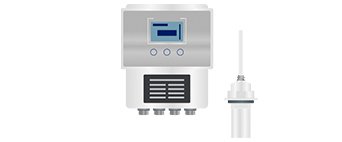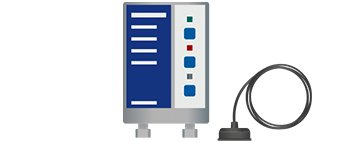Indicates, Measures and Controls the Level with the following technologies
The level of liquid and solid compounds (such as powders, mixtures, granulates, etc.) contained in containers, tanks, silos, diesel, oil, etc. is measured in height in metres.
Riels Instruments offers level sensors for tanks containing any type of material, these find application in cisterns, submersible pumps, wells, silos and many others.
In the case of liquids, the level or height measured is always the real effective average height of the liquid contained, while in the case of solids, the level or height measured is the real effective punctual height of the solid contained, height which is essentially a function of the measuring point.
The level sensors that you will find in the catalog are specifically designed for each specific purpose.
The main level meters and their operating principle are described below:
Capacitive level indicators are suitable for measuring liquids even at high pressures and temperatures and for powdery or granulated solids, which have a high and constant relative permittivity with respect to the vacuum, and typically air.
Probe level measurement is an automated measurement system, capable of periodically and/or continuously detecting the level of liquid, solid, mixtures, powders, etc., in tanks, silos and containers in general.
- Capacitive level indicators or Capacitive level transmitters
- Ultrasonic level indicators or Ultrasonic level transmitters
- Microwave level indicators or Microwave level transmitters
- Radar level transmitters
- Communicating vessel level indicators (visual or magnetic)
- Float level indicators
- Probe level indicators (immersion and float)
- Vibrating level indicators
- Rotating level indicators
- Magnetic level switch
- Resistive level indicators
- Optical level indicators
- Conductivity level indicators
- Levels by weight (load cells)
Level sensors for liquids and solids
Capacitive level indicators are suitable for measuring liquids even at high pressures and temperatures and for powdery or granulated solids, which have a high and constant relative permittivity with respect to the vacuum, and typically air.
These capacitive level transmitters allow continuous indication and level states. They are suitable for conductive and non-conductive liquids and offer good accuracy and good stability to mechanical and chemical aggression.
Ultrasonic level sensors are based on the variation of the transit time (or travel or flight) of a sound or an ultrasound, caused by the raising and/or lowering of the level in the tank to be measured.
The sound or ultrasound is emitted by a transmitter located at the top of the tank and is reflected by the level of the liquid or solid product in the tank, in a return echo detected by a receiver coupled to the transmitter.
Ultrasonic level transmitters are meters suitable for continuous indication and level status, suitable for liquids and powdery solids.
Ultrasonic level transmitters offer good precision and the measurement is independent of the physical characteristics of the product: (density mass, viscosity, etc.) and of the electrical characteristics of the product; (conductivity, permittivity, etc.)
Radar is defined as an electronic system capable of locating objects not visible to the naked eye and to determine their distance, speed, shape and size, exploiting the propagation properties of radio waves.
Radar level transmitters allow a measurement not in contact with liquids or solids, they are suitable for heavy pressure and temperature measurements, the measurement is independent of the product characteristics, they also offer high precision and repeatability.
The level meter with communicating vessels (visual) is a local level indicator made up of a column of liquid external to the container to be detected, suitable for high pressures and temperatures, it allows local indication of the level.
Similar level indicators with communicating vessels, but magnetic, have advantages which make them preferentially usable in the following applications of fluids: high pressure, high temperature, flammable or explosive, chemically aggressive, polluting for the environment, harmful or poisonous to the man.
Magnetic level gauges offer the advantage of local and remote indication. Compared to the previous visual level indicators, the measurement, instead of being read by the observer at the liquid/gas separation surface, is presented directly by the magnetic measuring device.
Level Sensors: Differences between Touch and Vibration
Probe level measurement is an automated measurement system, capable of periodically and/or continuously detecting the level of liquid, solid, mixtures, powders, etc., in tanks, silos and containers in general.
They are called probe level indicators as they automatically "feel" from the top of the container, the lowering of the contained material and therefore note the height of the container, determining the contained level.
Probing is carried out by a float suspended from a rope or a metal band, by a servo-driven motor which "feels" the floating of the float and transduces the lowering of the rope and/or the band, inversely proportional to the raising of the level , in a series of pulses directly displayed and/or transmitted at a distance.
Probe level indicators offer local and remote indication, are suitable for medium and high pressures, suitable for high heights (even over 20 meters), high precision (typically 1 mm).
The vibrating level indicators are suitable for level readings in liquids, powdery solids and solids in liquids.
They consist of a probe which, made to vibrate at its natural resonance frequency in the air, varies the vibration frequency in the presence of the liquid or solid to be detected.
Vibrating level indicators can be installed vertically or laterally to the tank to be detected and do not require calibration.
Rotating Level Sensors and Magnetic Float Level Switches
The range of level gauges includes rotary level indicators suitable for solid state measurement. They consist of a probe which is rotated by an electric motor. As the level increases, the measuring probe encounters greater resistance to rotation and therefore the increase in the rotation drive torque is detected by an electromechanical or electronic device which signals the level status.
Rotary level sensors do not require calibration and offer good repeatability.
Magnetic float level switches (or float level switches) are suitable for controlling the liquid level in tanks, vats, boilers and for controlling pumps, valves, alarm systems.
The assembly is vertical directly in the process or inserted laterally in a containment chamber external to the process.
Inside a blind vertical tube, in the lower part and integral with the fastening system, one or more contacts (up to six intervention points) with magnetic actuation (reed switch) are positioned.
One or more floats, free to slide along the guide tube, magnetically act on the contacts, switching their state according to the liquid level in the tank.
The switching points are defined during construction at the required heights and can be adjusted on site.
The magnetic float level switches can be equipped with a potentiometric transmitter for continuous level reading.














